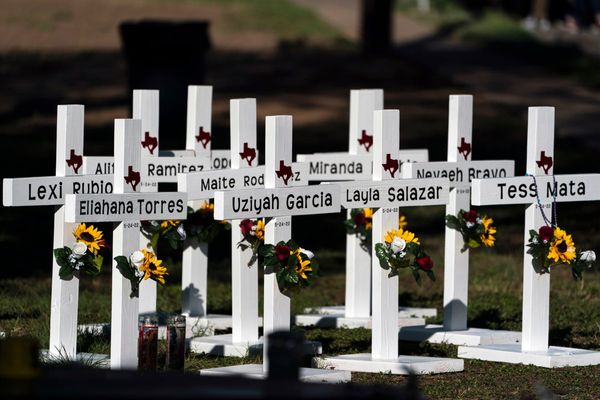
As Sudan’s civil war spirals deeper into turmoil, activists are remembering friends and loved ones killed during pro-democracy protests in Khartoum on June 3, 2019.
The killings, carried out by military forces in an effort to disperse a sit-in calling for civilian rule and democracy, marked a pivotal moment for Sudan after the April 2019 overthrow of former President Omar al-Bashir.
Before al-Bashir was deposed in a military coup, a large civilian protest movement had been demanding for months that the president step down. That movement continued after the imposition of military rule, eventually leading to what has become known as the “Khartoum Massacre”.
The same forces that took over from al-Bashir – Sudan’s military and the paramilitary Rapid Support Forces – are now fighting each other in a civil war that started on April 15, 2023. And many activists now believe that the June 3 killings were a sign of the devastating war that was to come.
Here’s all you need to know about the significance of the killings:
What happened?
The killings took place on the second to last day of the Islamic holy month of Ramadan. Thousands of protesters had remained at the sit-in, which began in early April in front of the military headquarters in Khartoum, despite rumours that security forces were planning to disperse them.
Sulima Shafiq, a pro-democracy activist who campaigns against violence against women and who was at the protest, said the sit-in participants believed “something [negative] could happen” but the actual events that transpired – including killings, rape and the detention of scores of individuals – were not anticipated.
At least 120 people were killed. Hundreds of others went missing.
“At some point, I thought that we wouldn’t make it and that we would die soon,” Shafiq told Al Jazeera. “I thought it was just a matter of time before we would be dead like all the others.”
Security forces initially denied attacking the sit-in after it was condemned globally. They also tried to limit any information from getting out by enforcing an internet blackout starting on June 10 as well as by restricting entry to foreign journalists.
The army authorities eventually admitted they had ordered the dispersal but said mistakes had been made.
Despite the killings, protesters spearheaded another march on June 30, prompting the international community to pressure the security forces into sharing power with civilian politicians in August 2019.
But the deal was not to last, and the civilian half of the transitional government was overthrown by its military partners in October 2021.

How has the pro-democracy movement adjusted since the war began?
Many of the sit-in participants are members of the resistance committees, which are neighbourhood groups that were instrumental in bringing down al-Bashir and organising sustained pro-democracy protests.
When the war started, many members of the resistance committees set up Emergency Response Rooms (ERRs). These new committees solicited donations from Sudanese people in the diaspora and assumed the task of alleviating the catastrophic humanitarian crisis brought on by the civil war.
ERR activists have cooperated to open first aid clinics, ferry civilians out of unsafe areas and run countless soup kitchens to feed the hungry.
In Khartoum, where severe fighting has taken place, Abd al-Qadous told Al Jazeera that his ERR has helped administer the nearest hospital. It has also opened up a small school to shelter displaced civilians who fled heavy fighting from nearby areas.
Al-Qadous, who survived the 2019 killings, said the ERRs are instrumental in helping civilians during the war. He added that it is imperative for ERRs to remain “neutral” in the conflict.
“We are not with any side, and we just believe in our humanitarian work and in neutral dialogue. This is what we learned from the [revolution that brought down al-Bashir],” al-Qadous said.
How have pro-democracy activists been impacted by the war?
Pro-democracy activists have been detained, tortured and killed by both belligerents in the war, al-Qadous said.
“There is torture … and death threats, and sometimes there are situations where [women] are raped,“ he told Al Jazeera.
In some districts, the de facto authorities have passed laws that prohibit ERRs or resistance committees from carrying out any humanitarian or political activities. But with aid groups often restricted by the parties to the conflict from reaching civilians in need, ERRs have little choice but to tend to their communities.
Fatma Noon, a spokesperson for the Kalakla resistance committee, told Al Jazeera in January: “We know the [belligerents] are targeting us.”

What is the legacy of the Khartoum killings on the war?
Pro-democracy activists have long decried the lack of accountability for both belligerents in the war.
They believe impunity has emboldened them to continue to attack and to sabotage popular aspirations for democracy so they can hold on to power and wealth.
Survivors of June 3 were particularly dismayed with what they described as a haphazard attempt by a legal committee that was tasked by the former civilian-military government to investigate the violent dispersal of the sit-in. The committee was supposed to produce a fact-finding report and press criminal charges, but the investigation was shelved after the 2021 military coup.
“The main reason for dispersing the sit-in was to stop the process of a democratic transition and handing power to civilians,” said one ERR member who requested anonymity due to fears of reprisals.
“The sit-in was also dispersed in order to scare and terrify revolutionaries … in order to retreat from the goals of the revolution.”







